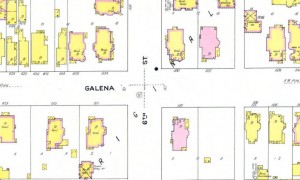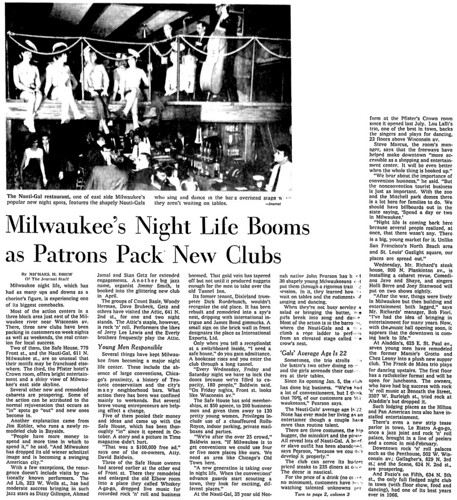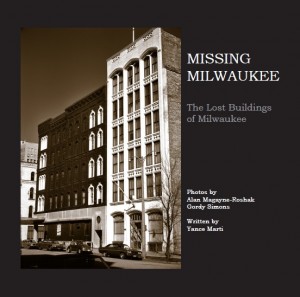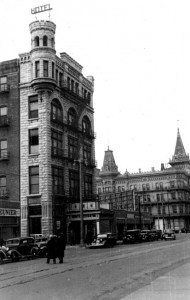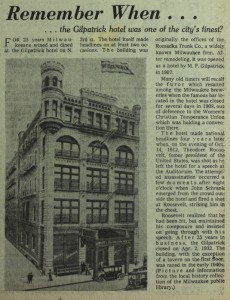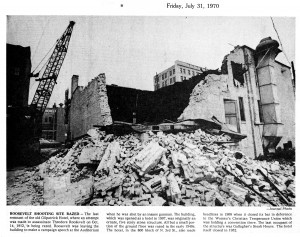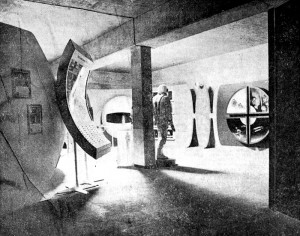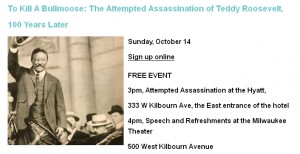The area around 5th, 6th & Galena was known as “Uihlein Hill” due to a number of Uihleins living in the area during the heyday of the Schlitz brewery. The Alfred Uihlein mansion sat at 1639 N. 5th St, and the home of Charles Uihlein and his wife Emma was at 609 W. Galena St.
This article tells about her death – the last of the Uihleins to live in this declining neighborhood. After her death, the city purchased the property and moved ahead with their redevelopment plans of the neighborhood.
Milwaukee Journal
August 20, 1946
Death Closes Cover on a Milwaukee Era
An era came to an end in Milwaukee Monday, an era which represented the Milwaukee that was truly half German. Mrs. Emma Uihlein died and the house on the hill is dark and silent.
Mrs. Uihlein lived for many years alone in the old brick home — alone except for the devoted housekeeper, Theresa Schmidt, who now cannot quite comprehend what has happened. Her mistress was 88 and she is – ach, let’s see once — well, maybe 72 and life is strange in the quiet house.
Miss Schmidt could not talk very much when the reporter called. All she could say was that her mistress was gone after being sick for “a long time already” and that she didn’t want to do much “speaking.” It will be very hard for the elderly spinster in the old home at 609 W. Galena st.
Charles Uihlein’s Widow
The determined old lady who now is gone was the widow of Charles Uihlein and mother of the late Oscar L. Uihlein, who headed the Uihlein Electric Co. here for 30 years. She died at Milwaukee hospital following a severe five week illness.
The old home in the city’s earlier years was one of a row of fashionable, ornate houses in the neighborhood that now has slipped into the worst blight of the city. It is in the southern corner of the sixth ward, where now the Negroes dwell in the ramshackle, tumble down houses that for years have mocked the old brick castle.
Mrs. Uihlein’s home was truly her castle. She would not leave it, come what might. She and the faithful Theresa held their ground behind the iron railing serving as fence and defied time to budge them. They shopped in the neighborhood – Theresa did most of it – and Mrs. Uihlein took long walks when her health was good.
Walks Remembered
Dwellers in the ward tell of watching the round old lady as she strolled in the warm afternoons around the neighborhood, looking with disapproving eye at what time was doing, but making no complaint. From the front veranda she could look across the street at the Philadelphia church. Back of her home, in the recent years, has been a firm of car movers.
The prospect was anything but beautiful, but nothing could have persuaded the old lady to surrender to the changing years. She kept her home in spotless order and dreamed of the days when the old home, was one of the best, and the finest people frequently dropped in for something from the cellar.
The home was built to be timeless. Its rich old woods would cause a twinge of envy to any antiquarian. A beautiful grandfather’s clock stands silent in the hallway. Portraits of the family stand in the living room, close to a lovely upright piano that may not have sounded music in a decade.
“Nein, nein.” Theresa Schmidt struggled to say Tuesday morning, “not much company we had for a long time.”
The housekeeper has lived in the home 45 years. She came from Germany as a “kleine maedchen” a long, long time ago. She worked in the Niedecken family five years, then was idle for a spell, but most of her life has been passed in the quietness of the hill.
Lower Their Voices
When they passed the old home, the Negro children were lowering their voices Tuesday, just as they have done for a long time. The old lady was thought of as patrician and her wishes were respected. The yard is as clean as any on Lake dr., even though the grass has trouble staying green under the protective trees.
Mrs. Uihlein is survived by Mrs. Oscar Uihlein of Grafton, another daughter-in-law, Mrs. Arthur C. Uihlein. of 2230 E. Bradford av.; a brother. Frank J. Kohn of Chicago; grand-daughter, Mrs. Kdward A. Banner of Grafton, and two great-granddaughters, Barbara Ann and Susan Banner.
Funeral services will be held at 2 p.m. Thursday from the Weiss funeral home at 1901 N. Farwell av. Burial will be in Forest Home cemetery. The body will be at the funeral home from 1 p.m. Wednesday until the hour of the funeral.
Few of the old friends can call at the funeral home, to share in the hushed reminiscence. An era has passed and gone. Only the dauntless could have remained as long as the little old lady just gone.